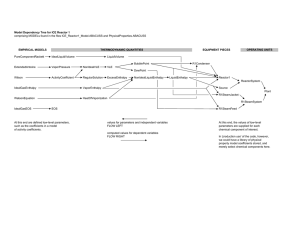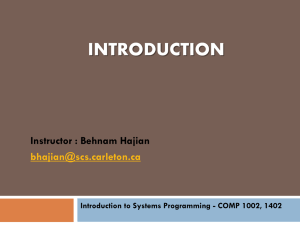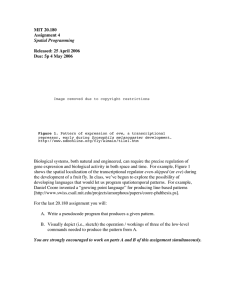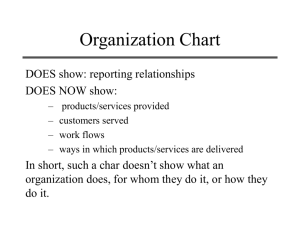Learning Executable Agent Behaviors from Observation
advertisement
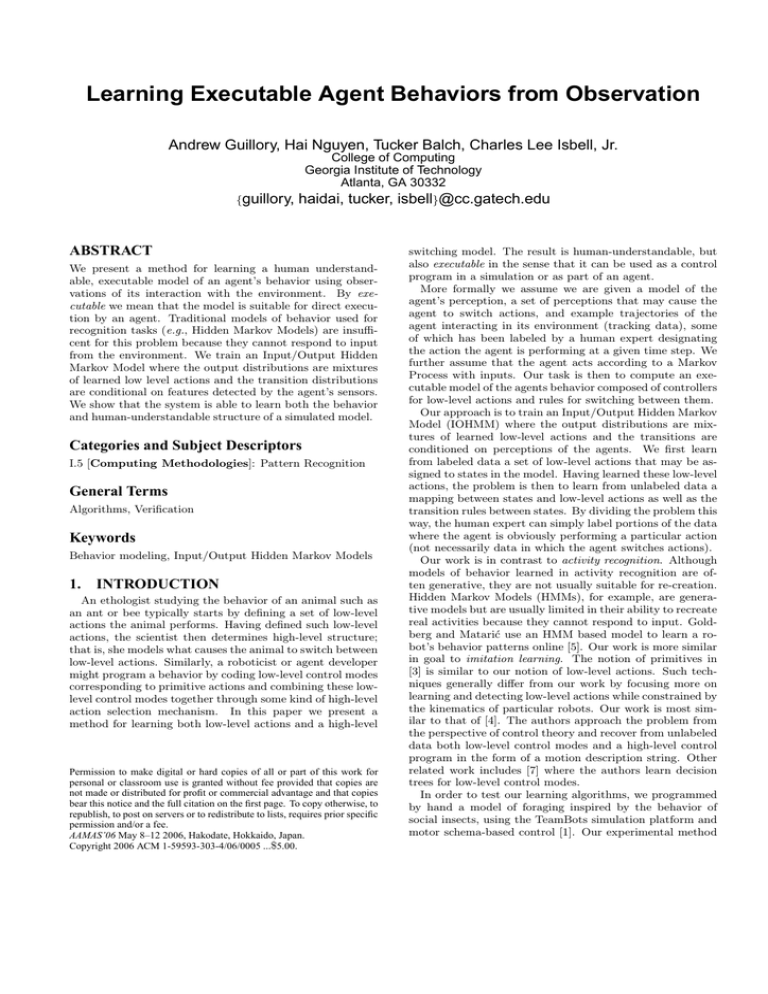
Learning Executable Agent Behaviors from Observation
Andrew Guillory, Hai Nguyen, Tucker Balch, Charles Lee Isbell, Jr.
College of Computing
Georgia Institute of Technology
Atlanta, GA 30332
{guillory,
haidai, tucker, isbell}@cc.gatech.edu
ABSTRACT
We present a method for learning a human understandable, executable model of an agent’s behavior using observations of its interaction with the environment. By executable we mean that the model is suitable for direct execution by an agent. Traditional models of behavior used for
recognition tasks (e.g., Hidden Markov Models) are insufficent for this problem because they cannot respond to input
from the environment. We train an Input/Output Hidden
Markov Model where the output distributions are mixtures
of learned low level actions and the transition distributions
are conditional on features detected by the agent’s sensors.
We show that the system is able to learn both the behavior
and human-understandable structure of a simulated model.
Categories and Subject Descriptors
I.5 [Computing Methodologies]: Pattern Recognition
General Terms
Algorithms, Verification
Keywords
Behavior modeling, Input/Output Hidden Markov Models
1.
INTRODUCTION
An ethologist studying the behavior of an animal such as
an ant or bee typically starts by defining a set of low-level
actions the animal performs. Having defined such low-level
actions, the scientist then determines high-level structure;
that is, she models what causes the animal to switch between
low-level actions. Similarly, a roboticist or agent developer
might program a behavior by coding low-level control modes
corresponding to primitive actions and combining these lowlevel control modes together through some kind of high-level
action selection mechanism. In this paper we present a
method for learning both low-level actions and a high-level
Permission to make digital or hard copies of all or part of this work for
personal or classroom use is granted without fee provided that copies are
not made or distributed for profit or commercial advantage and that copies
bear this notice and the full citation on the first page. To copy otherwise, to
republish, to post on servers or to redistribute to lists, requires prior specific
permission and/or a fee.
AAMAS’06 May 8–12 2006, Hakodate, Hokkaido, Japan.
Copyright 2006 ACM 1-59593-303-4/06/0005 ...$5.00.
switching model. The result is human-understandable, but
also executable in the sense that it can be used as a control
program in a simulation or as part of an agent.
More formally we assume we are given a model of the
agent’s perception, a set of perceptions that may cause the
agent to switch actions, and example trajectories of the
agent interacting in its environment (tracking data), some
of which has been labeled by a human expert designating
the action the agent is performing at a given time step. We
further assume that the agent acts according to a Markov
Process with inputs. Our task is then to compute an executable model of the agents behavior composed of controllers
for low-level actions and rules for switching between them.
Our approach is to train an Input/Output Hidden Markov
Model (IOHMM) where the output distributions are mixtures of learned low-level actions and the transitions are
conditioned on perceptions of the agents. We first learn
from labeled data a set of low-level actions that may be assigned to states in the model. Having learned these low-level
actions, the problem is then to learn from unlabeled data a
mapping between states and low-level actions as well as the
transition rules between states. By dividing the problem this
way, the human expert can simply label portions of the data
where the agent is obviously performing a particular action
(not necessarily data in which the agent switches actions).
Our work is in contrast to activity recognition. Although
models of behavior learned in activity recognition are often generative, they are not usually suitable for re-creation.
Hidden Markov Models (HMMs), for example, are generative models but are usually limited in their ability to recreate
real activities because they cannot respond to input. Goldberg and Matarić use an HMM based model to learn a robot’s behavior patterns online [5]. Our work is more similar
in goal to imitation learning. The notion of primitives in
[3] is similar to our notion of low-level actions. Such techniques generally differ from our work by focusing more on
learning and detecting low-level actions while constrained by
the kinematics of particular robots. Our work is most similar to that of [4]. The authors approach the problem from
the perspective of control theory and recover from unlabeled
data both low-level control modes and a high-level control
program in the form of a motion description string. Other
related work includes [7] where the authors learn decision
trees for low-level control modes.
In order to test our learning algorithms, we programmed
by hand a model of foraging inspired by the behavior of
social insects, using the TeamBots simulation platform and
motor schema-based control [1]. Our experimental method
Figure 1: On the left, our original model, including screenshots from the simulation. On the right, a high
likelihood learned model, showing the most likely transitions for every input, excluding self transitions.
Figure 2: Networks for IOHMMs and HMMs
was to generate data from this known model, then see if
we are able to automatically recover the behavior from the
data. Figure 1 shows our model. From the simulation we
created two data sets, one labeled with the action the agent
is performing at each time step and one unlabeled. For both
data sets we ran the model in simulation with 12 agents
at 33 frames per second, waiting for all of the targets to
be carried to base, recording at each frame the positions
and orientations of all agents as well as the positions of all
targets. Our goal is then to, from the labeled data set, learn
the low-level actions of the agent and, from the unlabeled
data set, learn the switching behavior.
2.
IOHMMS AS EXECUTABLE MODELS
HMMs [6] represent the probability of an observation sequence P (y1T ) where y1T = y1 ...yT is a sequence of observation vectors. IOHMMs [2] are a generalization of this
model that represent the conditional probability of an observation sequence given an input sequence P (y1T |uT1 ) where
ut is the input vector for time t. Figure 2 shows the dependency assumptions of the two models, where xt is the discrete state of the model at time t. The essential difference
between the two models, is that in an IOHMM the transition distributions P (xt |xt−1 = i, ut ) and output distributions P (yt |xt = i, ut ) are both conditional on the current
input vector. The standard algorithm for training IOHMMs
is an Expectation Maximization (EM) algorithm that is a
straightforward extension of Baum-Welch for HMMs. After training, the model can be interactively executed on an
input sequence in a manner similar to a finite state machine.
In our case, the input ut is the tracking data at time t, including the position of the agent. The corresponding output
yt is the next position of the agent after moving. By using
the model interactively in a simulator environment we can
recreate the global behavior of the agent. Although consis-
tent with previous papers on IOHMMs, our use of variable
names and the terms input and output are different than
their use in dynamic systems literature (where input often
refers to input into the environment).
We model output distributions as mixtures over already
learned low-level actions. Mixture distributions marginalize
a distribution over a discrete variable, in this case at , the
low-level action the agent is performing at time t. Normally,
a mixture distribution in an IOHMM would have mixing
weights conditioned on ut as well as xt . For our application, input-conditional mixing weights are undesirable because they complicate the meaning of a state–there is not a
simple mapping between states and low-level actions. Our
approach is to use unconditional mixing weights but also for
the purposes of parameter estimation model the output distributions as generating both ut and yt . This allows us to
represent information about ut without introducing inputconditional mixing weights. We further assume ut and yt
are independent of xt given at (that the low level actions are
the same for each state). The overall model is something like
an HMM/IOHMM hybrid: the transition distributions are
conditional while the output distributions are not. With
this model, assuming we have already calculated the values
for the mixture components at each time step, which we factor into P (yt |at , ut ) and P (ut |at ), only the mixing weights
need to be re-estimated during EM training.
We must also represent our transition distributions. In
our experiments we avoid some complexity and maintain
human understandability by conditioning the transition distributions on a set of binary sensory features calculated from
ut , just as we have done in our simulated domain. We can
then represent the transition distributions as look up tables. We experimented with ranking our binary features.
We then took as our input the most important triggered feature. This ranking method greatly reduces the number of
parameters and constrains the model to resemble hand-made
models where only a single binary feature triggers a transition. Unfortunately, choosing a feature ranking requires
domain knowledge. We also experimented with a standard
binary encoding, allowing for a different transition rule for
every possible combination of feature values.
When estimating probabilities in look up tables, it is standard to add a small constant to the counts for each entry to
allow some probability mass everywhere. In our case, it is
useful to add a small number to only the entries corresponding to self-transitions. In other words, given little evidence,
an agent should remain in its current state.
3.
LEARNING LOW-LEVEL ACTIONS
To estimate the mixing weights during EM from unlabeled
data we need to estimate values for P (yt |at , ut ) for each time
step and low-level action. To execute the resulting model,
we also need to be able to sample from this distribution.
Our approach to this problem is to learn a controller for
each low-level action from labeled data.
From labeled data, we can calculate sensory features and
corresponding motor commands for each low-level action
(example inputs and outputs for each controller). In our
experiments we solve the function approximation problem
by using a modified version of k-nearest neighbor (KNN),
randomly choosing from the k nearest neighbors with the
probability of each weighted by the point’s distance from
the query point. By randomly choosing in this way we can
model random actions like the Explore action. With the
learned controller and a simulation environment, we can
sample from P (yt |at , ut ) (i.e. simulate a single time step
of the agent’s motion). From this we can also estimate
values for the distribution for unlabeled data using kernel
density estimation. For each time step and action we run
a simulation many times to produce distributions of points
predicting the next position of the agent. We then compare these point distributions to the actual next position to
decide which action the agent is performing.
We also learn a model for P (ut |at ) from labeled input
vectors. We are not interested in sampling from this distribution as during execution our model does not generate ut ,
but we need to estimate its values in order to calculate the
mixing weights, since we modeled the output distributions
as joint distributions over ut and yt . In our experiments, we
again reduce ut to a set of binary features, using the same
features and encoding as we did for the transition distributions, and learn look up tables.
were also greater than the original model’s. Within these
models, there were several clusters of models whose likelihood scores were identical within range of our convergence
criteria. We tested models from each of these clusters. Figure 1 shows the model from the cluster with the highest
likelihood score for the ranked input type. The unranked
input type model is similar, except with more complicated
conditions on the transitions. 14 ranked and 21 unranked
models were within the maximum likelihood clusters.
All of the models that learned the correct structure were
able to recreate the forage behavior in simulation when combined with the learned controllers. However, they also all
had flaws that affected the behavior to varying degrees. For
example, many models did not know what to do when they
missed a target or another agent reached a target before
them. Some would even remain stuck in Move to Target in
this situation, in the worst case then becoming stuck against
a wall. Subjectively the models with the maximum likelihood scores seemed to recreate the behavior the best.
5.
6.
RESULTS
We used k-nearest neighbors on the agent’s sense-action
pairs to learn the low level controllers. For the sensory features we used distance and angle to the closest obstacle,
closest target, closest agent, and the base as well as whether
or not the agent is currently carrying a target. For the motor outputs we calculated the distance and angle the agent
moved at each time step as well as whether the agent was
carrying an object or not. We then tested the learned controllers in simulation using the original forage switching behavior. Our learned low-level controllers were able to recreate the original foraging behavior even on foraging arenas
where the position of food items are moved from their original position as well as differently sized arenas with more
attractors and more obstacles. Even though the agents were
able to recreate the original foraging behavior by successfully
gathering all the targets, there were still flaws. For example, the agents would frequently miss targets while moving
towards them in the Move to Target controller, especially
targets in corners.
With learned low-level actions, we trained 150 models
with EM for both ranked and unranked input types, and
40 ranked and 32 unranked input models learned the correct structure of the behavior (that there was one state for
each low level action). The likelihood scores for the models
that learned the correct structure were all higher than the
scores for the models that did not. Their likelihood scores
ACKNOWLEDGMENTS
Thank you to Sridhar Mahadevan, Zia Khan, and Adam
Feldman for helpful discussions. This work was supported
in part by NSF.
7.
4.
CONCLUSIONS AND FUTURE WORK
We have presented a method for learning an executable
model of behavior from observations. We tested our method
on simulated data generated from a hand-constructed model.
The learned models recreated the behavior of the original
model and exhibited the same basic structure. We hope to
next apply these techniques to actual insect tracking data.
REFERENCES
[1] R. C. Arkin and T. R. Balch. Aura: Principles and
practice in review. Journal of Experimental and
Theoretical Artificial Intelligence (JETAI),
9(2-3):175–188, April 1997.
[2] Y. Bengio and P. Frasconi. Input-output HMM’s for
sequence processing. IEEE Transactions on Neural
Networks, 7(5):1231–1249, September 1996.
[3] D. C. Bentivegna, A. Ude, C. G. Atkeson, and
G. Cheng. Humanoid robot learning and game playing
using pc-based vision. In 2002 IEEE/RSJ International
Conference on Intelligent Robots and Systems (IROS),
volume 3, pages 2449–2454, 2002.
[4] F. Delmotte and M. Egerstedt. Reconstruction of
low-complexity control programs from data. In 43rd
IEEE Conference on Decision and Control, volume 2,
pages 1460–1465, December 2004.
[5] D. Goldberg and M. J. Matarić. Detecting regime
changes with a mobile robot using multiple models. In
2001 IEEE/RSJ International Conference on
Intelligent Robots and Systems (IROS01), volume 2,
pages 619–624, 2001.
[6] L. R. Rabiner. A tutorial on hidden markov models and
selected applications in speech recognition. Proceedings
of the IEEE, 77:257–286, February 1989.
[7] C. Sammu, S. Hurst, D. Kedzier, and D. Michie.
Learning to fly. In Ninth International Conference on
Machine Learning, 1992.
